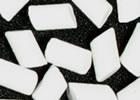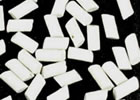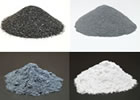Red Jasper - Rock Tumbler Rough
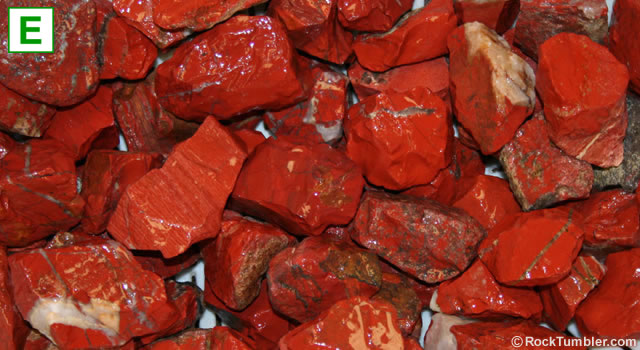
This image shows a bag of red jasper tumbling rough, dumped into a colander and sprayed with water to reveal its full color. Click on the image for a larger view. Wow! What a bright red color!
Red Jasper Tumbling or Cabbing Rough
 ,
,  , and
, and  What do they mean?
What do they mean?
Size: mostly 1/2 to 2 inch pieces
This red jasper from South Africa is one of our long-time favorite tumbling roughs. Why? Here are four reasons: 1) it accepts an awesome polish; 2) it has a spectacular red color; 3) it shapes nicely; and, 4) it is tough enough that bruising rarely occurs in the tumbler. That makes this rough easy and enjoyable to tumble. We recommend it as a great tumbling rough for beginners. Because the pieces are mostly 1/2 to 2 inches in size, it is also a good rough to use when learning about ceramic media.
This jasper is bright red in color and is nicely marked with a few veins and pockets of white to gray translucent quartz. It produces beautiful tumbled stones with a few interesting quartz veins. Rare pieces contain a tiny streak or a few specks of gray to silver hematite. The hematite suggests that this material was deposited in association with a banded iron formation. The rough in the photo above was photographed wet to show its full color.
This red jasper is sold in two-pound bags. Most pieces in the bag will measure between 1/2 inch and 1 3/4 inches in size (if measured along their maximum dimension). These will produce nice chunky tumbled stones.
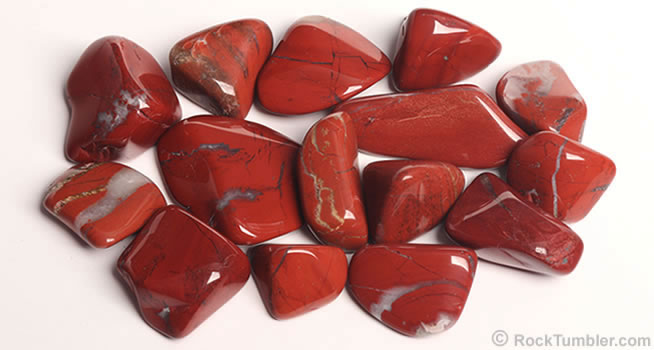
Shown here are some of the red jasper that we polished using the recipe below.
EASY Rock Tumbling Recipe:
Red Jasper (1/2 to 2 inches)
When tumbling this red jasper two things should be considered:
1) More Time: Although this Red Jasper is a little softer than most agates and shapes nicely, it is in large pieces that will require more time in coarse grit than beginner's tumbling roughs. In six, twelve and fifteen pound capacity barrels two weeks might be enough to shape the rough to your satisfaction. However, in small tumblers of two or three pounds capacity, three or four weeks might be needed. We suggest doing a clean-up at the end of two weeks, then decide if your Red Jasper needs more time in coarse grit to attain a nice shape and surface or if it is ready to begin the medium grit step.
2) Media Needed: This material is in pieces that range between 1/2" and 2" in size. For that reason, we add about 25% ceramic media to fill the voids between the larger pieces of rough. The cylindrical shape of the ceramic media acts like a roller bearing and gives the rocks a smooth tumbling action in the barrel. The small pieces of media also deliver grit to all surfaces of the rough.
| Using Small-Size Rough Instead of Media: Some people use small pieces of rough instead of media. This can work well if your small rough meets two requirements: 1) the small pieces of rough must be blocky or rounded in shape to produce a good tumbling action - thin or flaky pieces will break up quickly and might not produce a smooth tumbling action; 2) the small pieces of rough must have a hardness that is equal to or greater than the rough that they are tumbled with - if they are softer they will tumble into mud before their job has been done. |
Recipe for Rotary Tumbling
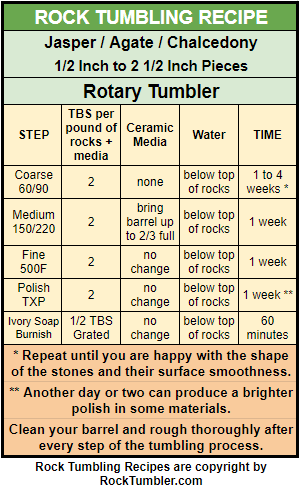
Coarse Grit Step: Fill your tumbler barrel 2/3 full of rough. Then add 2 tablespoons of coarse (60/90) grit per pound of material in the barrel. Add enough water to cover the tops of the rocks. Run the material in coarse grit for 2 weeks. After two weeks check your material. If you are happy with the shaping move onto the medium grit step. If more shaping is needed, clean the rough and start tumbling again with a clean barrel and fresh grit.
At the end of all steps in the rock tumbling process, make sure to clean your rocks and barrel to reduce the chance of coarser grit contaminating the finer grit steps. This cleaning is especially important before you begin the polishing step.
| How Many Weeks In Coarse? A little judgement will be needed because every barrel of rocks will be different. They have different sizes, different shapes, different compositions. And, tumblers come in many different sizes, different shapes and run at different speeds. The human brain must be used to get optimal results. You will become wiser and get better results through paying attention and gaining experience. |
Medium Grit Step: Put your cleaned rough back into the barrel. Then add 2 tablespoons of medium (150/220) grit per pound of material in the barrel. If the barrel isn't at 2/3 full, add a little more media to bring it up to operating capacity. Add water until it is just below the top of the rocks. Tumble for one week.
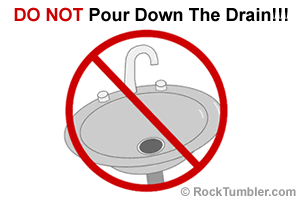
Barrel slurry dumped down the drain will harden like concrete.
Polish Step: IMPORTANT: Make sure that your barrel and rough have been cleaned thoroughly. Any grit carried over from a previous step will likely ruin your polish. Place the rough in the barrel with two tablespoons of TXP polish for each pound of material in the barrel. Add enough water to almost cover the rocks and let it tumble for one week. You should have polished rocks at the end of this step.
Burnish If Needed: This material usually takes a great polish. However, burnishing it after the polish step can often improve the look of the stones. If you would like to try burnishing, full instructions can be found here.
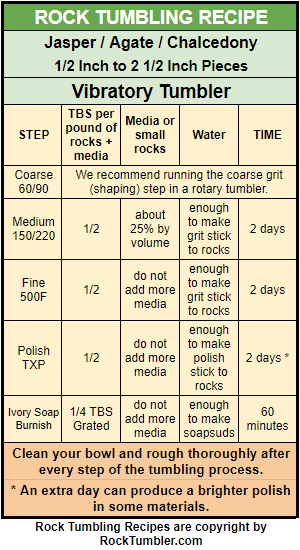
Vibratory Tumbler Recipe:
1/2" to 3" harder rough
Coarse Grit (60/90 Mesh):
Coarse grit is not used in a vibrating rock tumbler.
Medium Grit (150/220 Mesh):
Due to the size of this material, it is recommended that you begin with a minimum of 30% ceramic media. The use of this media will aid in the tumbling action in the barrel and help deliver grit to all surfaces of the rough
After you have your bowl loaded to the manufacturer's recommended level, add 1 tablespoon of grit for every two pounds of material, including the media, in the bowl. While the tumbler is running, slowly add water until the material has a thin coat of wet grit and the tumbling action is smooth and fast in the bowl.
Check the bowl every 8-12 hours to ensure the action is still good. If the action has slowed, add water a little at a time until the action is back to normal. If the mud gets too thick you will need to do a complete rinse of the material and bowl. After rinsing, add fresh grit and water and start tumbling again. You are done with medium grit when you are satisfied with the shape and smoothness of the stones. Usually 4-7 days for us with this material. Give the material and bowl a thorough cleaning before moving on to fine grit.
Fine Grit (500F Mesh):
Place your material back in the tumbler bowl, then add enough polished ceramic media to bring the load up to the manufacturer's recommended operating level. Add one tablespoon of grit for every two pounds of material in the bowl. Then, turn the tumbler on and slowly add water until the material has a thin coat of wet grit and the tumbling action is smooth and fast in the bowl.
Open the bowl every 8-12 hours to check the action is still good. We usually run fine grit for 48 hours. Thoroughly clean the bowl and material before moving to the polishing step.
Polish (#61 Rapid Polish or TXP):
Place the cleaned material back in the bowl. If needed, add ceramic media that has been previously polished, to bring the bowl up to the manufacturer's recommended operating level. Add one tablespoon of polish for every two pounds of material in the bowl. Turn on the tumbler and slowly add water. Stop adding water when the material has a thin coat of wet polish and the tumbling action is smooth and rapid.
Like the previous grit steps, open the bowl every 8-12 hours to check the tumbling action. Add water if it has slowed. We have found that 48 hours is usually all the time you need to get a good polish in a vibratory tumbler. Any more time than that and you run the risk of damaging / bruising the material.
Burnish If Needed:
This rough will usually take a great polish. However, burnishing this material after the polish step can often improve the look of the finished stones. If you would like to try burnishing to see if it improves the look of your polished stones, full burnishing instructions can be found here.
Other Uses:
Some people like this rough so much that they use it for coarse ground cover in potted plants and planters. Others scatter a few pieces around their landscaping to add a little color. If we did that at our house, the neighborhood kids would probably become "collectors." :-)
Finished Red Jasper Tumbled Stones:
If you don't want to tumble this red jasper yourself, we usually have medium size (5/8" to 1") tumbled stones of this material for sale by the pound. You can find them here.
Customers also bought...
Large Ceramic Media

Small Ceramic Media

Standard Grit Kit



